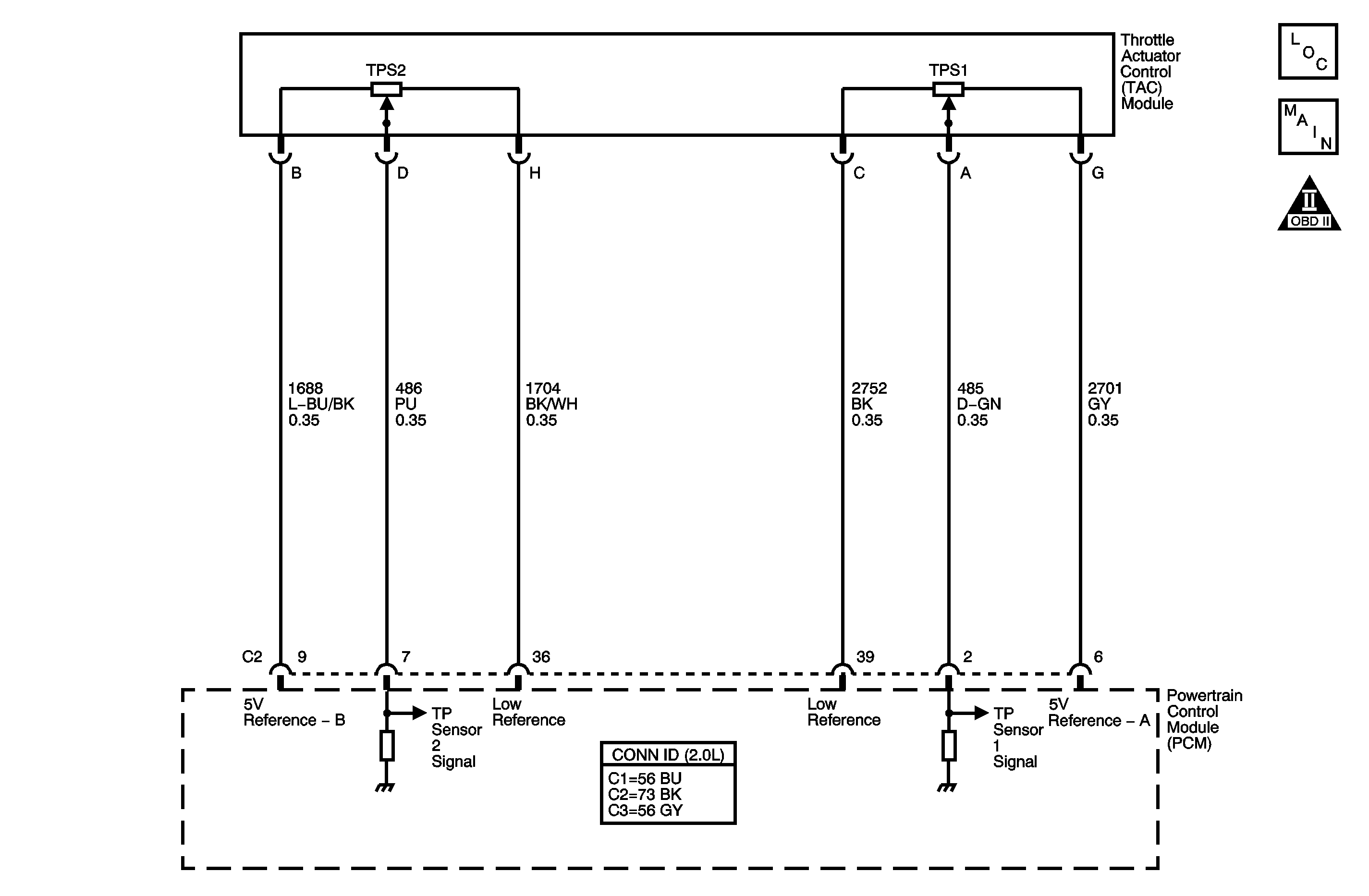
Circuit Description
The powertrain control module (PCM) uses the following information to calculate an expected airflow rate:
| • | The throttle position (TP) |
| • | The barometric pressure (BARO) |
| • | The manifold absolute pressure (MAP) |
| • | The intake air temperature (IAT) |
| • | The mass air flow (MAF) |
| • | The engine RPM |
If the PCM detects the airflow rate is more than expected, DTC P0121 sets.
Conditions for Running the DTC
| • | DTCs P0641, P0651, P1516, P2101, P2119, P2176 are not set. |
| • | The engine is running and the engine speed is more than 600 RPM. |
Conditions for Setting the DTC
The PCM detects that the calculated airflow rate is more than expected.
Action Taken When the DTC Sets
| • | The control module illuminates the malfunction indicator lamp (MIL) when the diagnostic runs and fails. |
| • | The control module records the operating conditions at the time the diagnostic fails. The control module stores this information in the Freeze Frame and/or the Failure Records. |
| • | The control module commands the TAC system to operate in the Reduced Engine Power mode. |
| • | A message center or an indicator displays Reduced Engine Power. |
| • | Under certain conditions the control module commands the engine OFF. |
Conditions for Clearing the MIL/DTC
| • | The PCM will turn OFF the malfunction indicator lamp (MIL) during the third consecutive trip in which the diagnostic has run and passed. |
| • | The history DTC will clear after 40 consecutive warm-up cycles have occurred without a malfunction. |
| • | The DTC can be cleared by using a scan tool. |
Test Description
The numbers below refer to the step numbers on the diagnostic table.
-
This step will determine if the manifold absolute pressure (MAP) sensor voltage is within the proper range at idle.
-
This step will determine if the MAP sensor responds properly to the change in manifold pressure.
-
When the PCM detects a condition within the ETC system other DTCs may set due to the many redundant tests run continuously on this system. Locating and repairing 1 individual condition may correct more than 1 DTC. Keep this in mind when reviewing captured DTC info.
Step | Action | Values | Yes | No | ||||||||
|---|---|---|---|---|---|---|---|---|---|---|---|---|
Schematic Reference: Engine Controls Schematics Connector End View Reference: Powertrain Control Module Connector End Views or Engine Controls Connector End Views | ||||||||||||
1 | Did you perform the Diagnostic System Check-Engine Controls? | -- | Go to Step 2 | |||||||||
2 | Are DTCs P0120, P0220, P1516, P1523, P2101, P2135 or P2176 also set? | -- | Go to Step 3 | |||||||||
3 |
Did the DTC fail this ignition? | -- | Go to Step 4 | Go to Intermittent Conditions | ||||||||
4 | Inspect for the following conditions:
Did you find and correct the condition? | -- | Go to Step 9 | Go to Step 5 | ||||||||
Is the MAP sensor voltage within the specified range? | 0.8-4 V | Go to Step 6 | Go to DTC P0106 | |||||||||
Does the MAP sensor kPa change smoothly and gradually as engine speed is increased and returned to idle? | -- | Go to Step 7 | Go to DTC P0106 | |||||||||
7 |
Does the MAP sensor kPa change smoothly and gradually as the engine speed is increased and is returned to idle? | -- | Go to Step 8 | Go to DTC P0101 | ||||||||
8 |
Caution: Turn OFF the ignition before inserting fingers into the throttle bore. Unexpected movement of the throttle blade could cause personal injury.
Did you find and correct the condition? | -- | Go to Step 9 | Go to Intermittent Conditions | ||||||||
Did the DTC fail this ignition? | -- | Go to Step 2 | Go to Step 10 | |||||||||
10 | Observe the Capture Info with a scan tool. Are there any DTCs that have not been diagnosed? | -- | System OK | |||||||||
